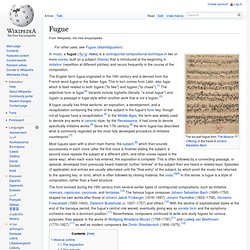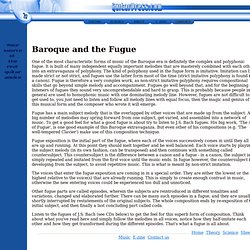

Fugue. Fugue. The English term fugue originated in the 16th century and is derived from the French word fugue or the Italian fuga.

This in turn comes from Latin, also fuga, which is itself related to both fugere ("to flee") and fugare ("to chase").[1] The adjectival form is fugal.[2] Variants include fughetta (literally, "a small fugue") and fugato (a passage in fugal style within another work that is not a fugue).[3] Musical outline[edit] A fugue begins with the exposition and is written according to certain predefined rules; in later portions the composer has more freedom, though a logical key structure is usually followed.
Further entries of the subject will occur throughout the fugue, repeating the accompanying material at the same time.[13] The various entries may or may not be separated by episodes. What follows is a chart displaying a fairly typical fugal outline, and an explanation of the processes involved in creating this structure. The exposition[edit] Example of a tonal answer in J.S. Listen. Baroque and the fugue. One of the most characteristic forms of music of the Baroque era is definitely the complex and polyphonic fugue.

It is built of many independent equally important melodies that are masterely combined with each other into an extravaganza of polyphony. The kind of polyphony used in the fugue form is imitative. Imitation can be made strict or not strict, and fugues use the latter form most of the time (strict imitative polyphony is found in a canon).
Fugue is therefore a very complex work, as non-strict imitative polyphony requires compositional skills that go beyond simple melody and accompaniment. Fugues go well beyond that, and for the beginning listeners of fugues they sound very uncomprehendable and hard to grasp. Fugue has a main subject melody that is the overlapped by other voices that are made up from the subject. Fugue exposition is the initial part of the fugue, where each of the voices successively comes in until they all are up and running. Listen to the fugues of J.S. 10 Great Fugues Not By Bach. The Arts This lister originally intended to write a list of the ten greatest fugues ever, but all ten, and the next 300 or so, would be by Johann Sebastian Bach.

So for some interesting diversity, here are ten outstanding fugues from other composers. These are not the ten greatest that are not by Bach, but simply ten great fugues. Certainly, many worthy examples have been left off, so you are invited to mention your choices. Fugue in C Major Johann Pachelbel Yes, as a matter of fact, Pachelbel wrote more than one Canon in D Major. This fugue is the lister’s favorite of those that YouTube has to offer, but he could find no opus number for it, and Pachelbel is sure to have written dozens of fugues over the years in C Major, as well as all the other keys.
Fugue #4 in e Minor. Toccata and Fugue in D Minor (Best Version Ever) Fugue in D Minor for Baroque Lute - P. West. Original Fugue in C major (Klavier) in Baroque Style R 744. J.S. Bach Fugue in G Major "Gigue", BWV 577, Anthony Newman, Organ.